Deze blog bevat een presentatie over de Community of Practice (CoP). Een CoP is een verzameling mensen die ervaring delen.
Opvallend is dat de zuivere Community of Practice niet voorkomt. Dat komt omdat men Kennis (Theorie) en Ervaring (Praktijk) door elkaar haalt.
De verwarring ontstaat omdat men de theorie als “dwingende” ervaring ziet. De theorie is foutloos. De gebruikers van de theorie maken fouten die worden veroorzaakt door tekortkomingen bij de gebruiker en niet in de theorie.
Doordat de gebruiker volgens de regels werkt en het mislukken van de regels door de gebruiker komt en niet door de regels wordt de theorie niet aangepast en worden de mislukkingen geaccepteerd totdat het systeem zich volledig volgens de regels gedraagt.
Het idee dat de praktijk ondergeschikt is aan de theorie is ontstaan in de Verlichting, een periode die samenvalt met de 18de eeuw.
In die tijd werd de verbeelding (het creatieve) teruggebracht tot de fantasie en werden de emoties (die waarderen) gezien als een geestelijk probleem (“hysterie“). Het enige wat telde was de ratio die werd vertaald in logisch redeneren.
In de verlichting ontstond de conduit-metafoor, een model waarbij communicatie een proces is waarbij conduits (objecten, containers) worden uitgewisseld die door iedereen te begrijpen kennis bevatten.
Dit in tegenstelling tot de toolmaker-metafoor waarin de mens zijn waarheid toont in zijn handelen (“The Truth of the Pudding is in the Eating“, (Miguel de Cervantes, Don Quixote (1615))).
Er zijn vier uitspraken over Waarheid mogelijk:
(1) De waarheid van een theorie is objectief.
(2) De waarheid van een theorie is gebaseerd op de waarneming van dat wat gebeurt (een feit is een gebeurtenis (een geboorte)).
(3) De waarheid van een theorie is een mening, een waardering: “If we have Analyzed Judgment, we have solved the problem of Truth” (F.P. Ramsey, Fact and Propositions, 1927). Wat (belangrijke) mensen vinden (zoals de Paus of een Hoogleraar) is waar.
(4) De waarheid van een theorie is het gevolg van een persoonlijk inzicht. Vaak het resultaat van een waarom-vraag. Wat ik geloof is waar.
De vier kijken op de waarheid kunnen worden ondergebracht in een vierluik wat door Jung een Quaternio werd genoemd. Een Quaternio bestaat uit twee tegendelen en twee complementen.
Een Inzicht is het gevolg van een uitzicht, een waarneming die in een waargeving resulteert (Waar -> Weer, Beeld, Idee).
De waarheid is objectief (context-vrij) en subjectief (wat anderen er van vinden, context-afhankelijk).
Ervaring is wat de mens al doende in de werkelijkheid als afwijking van zijn eigen theorie, zijn Verwachting (Overtuiging), meemaakt. Ervaring is een persoonlijke reflectie op het persoonlijk handelen.
Een Community of Practice (CoP) lijkt erg veel op het Middeleeuwse Gilde met als groot verschil dat lokatie geen rol meer speelt zodat een Gilde niet meer bij een Stad hoeft te horen maar in theorie wereldwijd kan opereren.
Door de enorme schaal die nu optreedt is het vrijwel onmogelijk om een eenduidig definitie voor een gilde te formuleren waardoor er veel communities zijn die min of meer hetzelfde gebied betreffen.
Dit is voor een deel opgelost door de gildes om te zetten in Internationale Standaard/Beroeps Organisaties die zich bezig houden met het ontwikkelen van Normen. Normen zijn theorieen die door een groep mensen worden geaccepteerd.
De belangrijkste factor in een Gilde is het Delen van Fouten waardoor de Theorie van de Gezellen kan worden verbeterd. In de huidige tijd hebben mensen erg veel moeite met het delen van Fouten omdat Fouten maken wordt gezien als Falen.
De werkwijze om een eerste versie van een CoP op te zetten lijkt erg veel op het ontwikkelen van een Expert-Systeem, waarbij de Meesters en Gezellen de Experts zijn en de Fouten (Failures) door de leerlingen worden geleverd.
Aangezien iedereen een leerling is geweest kan iedereen een relatie leggen tussen een veelgemaakte fout en een oplossing van de fout.
In het algemeen maken mensen steeds weer dezelfde fouten als ze met een beroep beginnen behalve als de fout structureel in het ontwerp- en bouwproces is geadresseerd.
Op dit moment bestaan er miljoenen communities die kunnen worden getypeerd door de Menselijke Persoonlijkheid die een combinatie is van Kennis (Wikipedia), Ervaring (Praktijk), Relaties (Sociaal, Facebook) en Creatief (Inzicht, Interesse, Linkedin).
Wat nu volgt zijn de sheets van de presentatie met toelichting in presentatievorm.

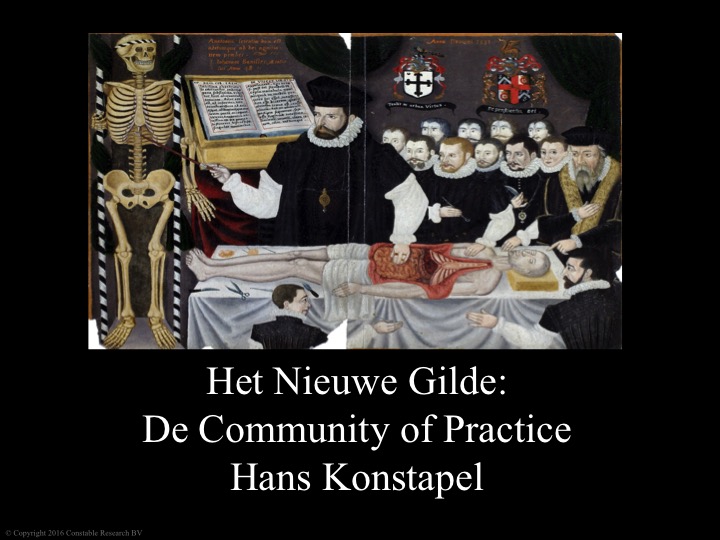
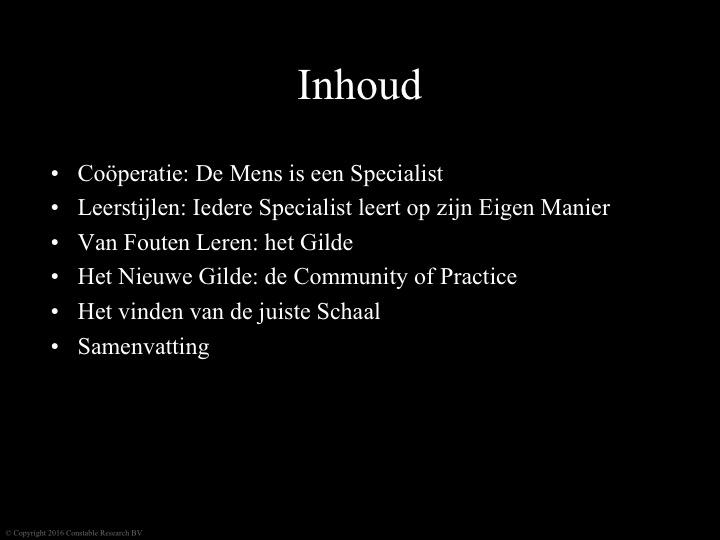
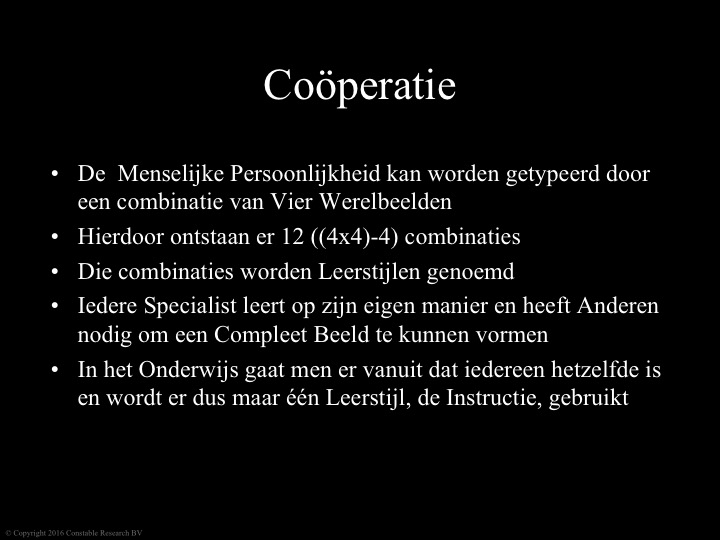
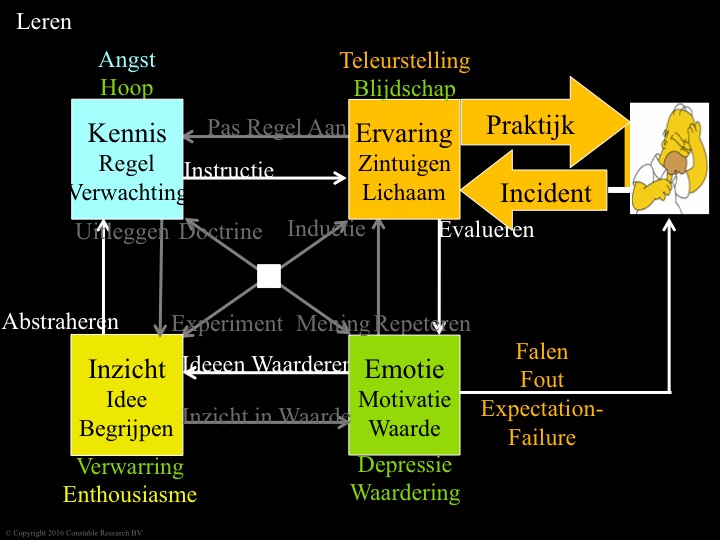







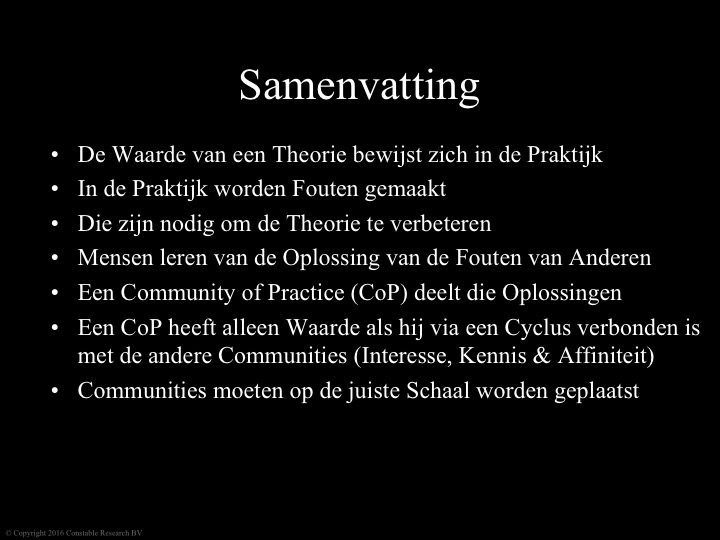
 The Industrial Revolution started with the mechanization of the textile-industry (1740-1790) in England.
The Industrial Revolution started with the mechanization of the textile-industry (1740-1790) in England. This tension was resolved when many pressure groups or movements (Conservatives, Liberals, Socialists, and Communists) finally agreed upon new large scale institutions.
This tension was resolved when many pressure groups or movements (Conservatives, Liberals, Socialists, and Communists) finally agreed upon new large scale institutions.  In 1781 Kant wrote his book Kritik der reinen vernunft. He excluded the Imagination (illusions) and the Emotions (love, care, values, quantity) out of reasoning and introduced the concept of mechanized thinking (Logic). Kant excluded Art (Imagination) and Religion (the Emotions) and invented Science.
In 1781 Kant wrote his book Kritik der reinen vernunft. He excluded the Imagination (illusions) and the Emotions (love, care, values, quantity) out of reasoning and introduced the concept of mechanized thinking (Logic). Kant excluded Art (Imagination) and Religion (the Emotions) and invented Science. Between 1790 and 1840 the world was covered with Railroads. They facilitated the spread of the Industrial Revolution.
Between 1790 and 1840 the world was covered with Railroads. They facilitated the spread of the Industrial Revolution. The first step was set by Henry Ford and Frederick Winslow Taylor with the production of the T-Ford. The theories of Taylor are until now (most of the time not recognized) used in many forms to optimize work-processes.
The first step was set by Henry Ford and Frederick Winslow Taylor with the production of the T-Ford. The theories of Taylor are until now (most of the time not recognized) used in many forms to optimize work-processes.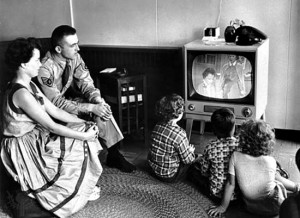 The Industrial Revolution gave the Masses, the Slaves of the Middle Ages a better place. They changed from a Slave into a Consumer.
The Industrial Revolution gave the Masses, the Slaves of the Middle Ages a better place. They changed from a Slave into a Consumer. On the level of the
On the level of the 